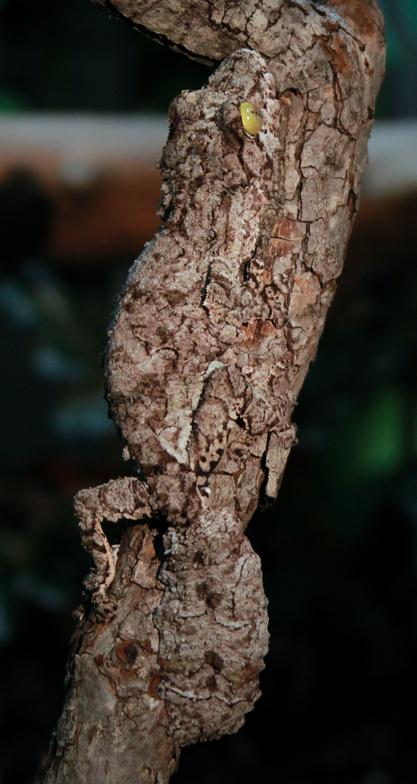Uroplatus are a cool tropical gecko species found only in the northwest and eastern coast of Madagascar. There are currently fourteen species of Uroplatus with new species being found from time to time. Each species has its own husbandry requirements, so when researching be specific about the species you want to work with. When researching, use information from an established, respectable breeder. I have seen a lot of bad information in the past. Select a Uroplatus forum for support (I highly recommend this forum at Geckos Unlimited).
For years there were just a few of us breeders and many of us had to start with wild-caught Uroplatus. They arrived stressed, dehydrated and full of parasites which gave the species a bad name. They were hard to keep because of these health issues.
Over the past three years, the number of Uroplatus breeders have increased in the United States. Consequently, captive bred Uroplatus can now be found more often than in the past. They are not as hard to keep as most people think.
Why are Uroplatus So Relatively Hard to Keep?
If you have a busy life-style then Uroplatus may not be for you. They need more attention than most other gecko species in terms of proper humidity levels, proper temperature levels as well as vitamin supplements.
Humidity
Uroplatus , being from the coastal areas of Madagascar, require high humidity. During the day, 65 to 70 % humidity is needed; at night 80-90% levels are optimal. Humidity levels can be maintained by spraying the tank at night with water. You can also cover part of the top lid which will boost the humidity. Make sure your substrate is allowed to dry out a little during the day. Too much moisture can cause harmful bacteria and mold growth. Low humidity will cause shed issues as well as dehydration. The first signs of dehydration include a shrunken or wrinkled tail or thick clear saliva while drinking. If dehydration occurs, use an eye dropper and slowly drip fluids on the nose or snout so the gecko can lick it off. If severe dehydration occurs you may need to see a vet who will inject fluids.
A rain chamber or shower stall works great. Just make sure you use a fine misting head. Standard shower heads are too strong. Use a pump sprayer or bounce water off the walls of the shower to create a finer mist.
If you spray your Uroplatus every night and keep humidity levels on the high side you should be just fine.
Temperature
Temperature is another issue I see with this species. Most people make the mistake of keeping them too warm or too hot. The optimal temperature really depends on the species. Each has its own requirements. Most are kept at 75F, days, and nights at 65F to 70F. Try not to let it get over 80F. This could cause stress and even death. The smaller species need even lower temperatures. Do your research on the species you want to work with.
Supplementation
Vitamin supplementation is another problem I see with Uroplatus. Vitamins are needed for maintaining good health. For years Uroplatus breeders have debated the issue of how much UV is required. Now field studies show that they need some UV as well as D3 supplements. They are needed for proper bone growth as well as egg production.
I have seen many cases where metabolic bone disease set in with gravid females or females that have produced a lot of eggs. Gravid females are in need of more calcium with D3 to maintain egg production and proper bone growth.
The first signs of metabolic bone disease in Uroplatus include uncontrolled shaking of the toes, soft or disfigured lower jaw and depleted calcium sacs under the jaw of gravid females. If you have an issue with metabolic bone disease seek a vet for proper calcium doses.
If you want to start keeping Uroplatus , just remember they do take time to work with. Do your research. I also recommend joining a Uroplatus forum for information and support.
Contact us if you have any questions (email: [email protected] or check our web site at www.uroplatusspecialties.com). We’ll be glad to help you.


